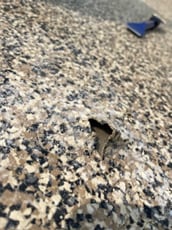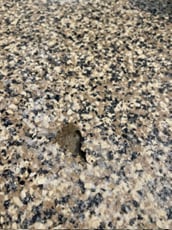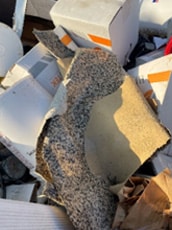Polyurea & Polyaspartic Coatings
There are several types of concrete coatings available on the market today – epoxies, polyurethanes, polyureas and polyaspartics. But it is the polyurea and polyaspartic coating types that have created such a buzz in the concrete coatings industry. These coatings have become a favorite of installers…the fast-cure capability of polyurea and polyaspartic coatings is often advertised as a panacea and has led to the mass-marketing of “1-day coating” systems. However, it’s also created some confusion for homeowners in the process.
If polyurea and polyaspartic coatings aren’t epoxies or polyurethanes, what are they exactly? And why would you want it on your garage floor? Why are coating companies pushing “1-day” polyurea-polyaspartic floor coatings so hard?
We’ll get to the nitty-gritty of all this in this article.
What are Polyurea and Polyaspartic Coatings?
Pure polyureas are a subgroup of polyurethanes. They are 2-component concrete coating products (Parts A and B). When the two parts are mixed, they quickly catalyze (“cure”) and produce a mixture that becomes very hard, very quickly. The mixture has low to no volatile organic compounds (VOC’s) and is very flexible. Because of its extremely fast cure rate (less than 5 seconds) and incredible hardness (in less than 5 minutes), pure polyureas require specialized equipment for application, like portable reactors.
What’s a polyaspartic? Bayer Material Science describes it as follows: “By definition, a polyaspartic polymer is an aliphatic polyurea because it is the reaction of an aliphatic polyisocyanate with an aliphatic diamine – the polyaspartic ester”. Yikes! A simpler explanation is that a polyaspartic is a polyurea with a slowed-down cure rate. The slowed cure rate allows trained applicators to apply polyaspartics in a less hurried manner with traditional rollers or squeegees…that is, specialized equipment is simply not required.
In a nutshell, all polyaspartic coatings are modified (aliphatic) polyureas. What this means for the homeowner is that when you see a garage floor coating or kit being advertised as a polyurea, it is likely an aliphatic polyurea….a slowed-down version of a pure polyurea called a polyaspartic.
Benefits of Polyurea Polyaspartic Coatings
The two biggest advantages of polyurea polyaspartic coatings are temperature and time. Unlike an epoxy, a polyurea polyaspartic coating can be applied in low (and high) temperatures. In addition, due to their fast-cure properties, a polyurea polyaspartic coating system, under certain conditions (where the concrete measures a very low moisture content), can be applied in 1-day with a “return-to-use” the following day. Conversely, if an epoxy is used in a coating system (as the primer coat, for example), the installation duration takes 2 days (not 1).
Other benefits of polyurea polyaspartic coatings include:
- 100% UV stable (no yellowing!)
- Crystal clear finish that repels moisture
- High gloss finish
- High abrasion and scratch resistance
- High stain and chemical resistance
- High tolerance to heat (hot-tire pick up is not an issue where quality polyaspartics are used)
- Low or no VOC’s
- Flexible, high-impact resistance
Disadvantages of Polyurea Polyaspartic Coatings
Though polyurea-polyaspartic coatings possess incredible benefits, they have one significant drawback – they generally aren’t suitable for direct-to-concrete application (because they don’t mitigate well for moisture). That is, they shouldn’t be used as a primer coat, especially under medium to high-moisture concrete conditions (as measured by a moisture meter).
With concrete, moisture wicks up through its pores in a process called moisture-vapor transmission (MVT). As a (hydrostatic) pressure builds, it pushes up against the primer coat. The wafer-thin polyurea-polyaspartic coat can’t withstand these high hydrostatic pressures and has a propensity to peel (delaminate). This is a common problem with coating systems that use a polyurea-polyaspartic direct-to-concrete! And this is exactly why “1-day polyurea” contractors never warrant their coating systems against “moisture-related issues”, and in some cases, hot-tire transfer too (aka plasticizer migration).
The photos below are actual pictures of a “1-day polyurea” coating system that was previously installed. It didn’t last long. See how the coating lifts from the concrete substrate almost like vinyl flooring! This is a prime example of a “1-day polyurea” coating that delaminated after being applied to concrete with high moisture content.
Photos 1-3: “1-day polyurea” coating system that has completely delaminated. Polyureas are a poor choice as the primer (direct-to-concrete) coat given that they do not properly mitigate for moisture. Under medium to high concrete moisture conditions, these coatings peel, which is exactly why they are never fully warranted for “moisture-related issues”.
Then Why Install This Type of Flooring?
Using a fast-curing polyurea polyaspartic as both the primer coat (direct-to-concrete) and the clear top coat, allows contractors to install this flooring in the promised “1-day” duration. But we now know that using a polyurea polyaspartic as the primer is like playing Russian Roulette! If the moisture in the concrete is too high (if the hydrostatic pressures are high), these coatings delaminate. If your contractor suggests a “1-day” polyurea polyaspartic coating without first assessing the moisture in your concrete floor, let the buyer beware!
But if moisture in the concrete is a serious issue for these coating systems, why would a contractor take the chance and sell “1-day polyurea-polyaspartic” flooring at all? Because they’re profitable! One-day polyurea polyaspartic coating systems use less product (a wafer-thin primer and single top coat) and they only require one day of labor (not 2).
This is great for the contractor…just not so great for the customer.
All Coating Types Have Advantages & Disadvantages
I mentioned at the beginning of this article that there are several coating types – epoxies, polyurethanes and polyurea-polyaspartics. Despite what “1-day” installers tell you, all coating types have advantages and disadvantages. Although polyurea polyaspartic coating types are great products, we’ve already seen that they do have a major drawback (they’re lousy primers).
Epoxy and polyurethane coatings are also great products…yet possess significant drawbacks. Epoxies, for example, can “amber” or “fade” if exposed to UV light (the sun) and are susceptible to staining and tire lift. Applying an epoxy as the final coat to UV-exposed concrete would be a bad use of this coating type. But epoxies are “high-build” coatings that can take “unfriendly substrates” like concrete and make them “friendly” for the application of subsequent coats. A 100%-solids moisture-mitigating epoxy can provide deep substrate penetration and mitigate substrate moisture (and the resulting hydrostatic pressure)…so they’re excellent primer coats!
Although a polyurethane can provide highly durable, application-friendly, UV and stain-resistant flooring, this “older technology” coating doesn’t provide the binding strength or millage (“build”) of an epoxy. They’re also susceptible to staining by plasticizers in new technology tires. So, although polyurethanes may be good choices on exterior patios and buildings, they’re lousy choices for any substrate upon which vehicles will be parked for extended periods.
Building the Best Coating System
As we’ve seen, all coatings – including polyurea and polyaspartic coating types – have advantages and Achilles heels. Building the best coating system (a coating “system” consists of multiple coats, often of differing coating types) requires the contractor to use the best properties of each coating type for the unique space to be coated!
We’ve seen that a 100%-solids moisture-mitigating epoxy, especially under medium to high concrete moisture conditions, is the best primer coat (because these “high-build” primers resist high hydrostatic pressures). And we’ve seen that a polyurea-polyaspartic are excellent, quick-curing top coats possessing extreme UV and stain-resistance (including resistance to hot-tire transfer)…but they’re lousy direct-to-concrete primer coats.
So, for garage floor installations, where the concrete has a high propensity for moisture-vapor transmission (MVT) and the top coat will certainly be exposed to UV light and chemical staining from automotive fluids and hot-tires, the best coating system would use a 100%-solids, moisture-mitigating epoxy as primer and a polyaspartic as the clear top coat.
“1-day polyurea” contractors know this, but the temptation of quick-cure, low-labor systems is strong. And the work-around is simple: offer a (limited) lifetime or long warranty to the customer, but add a warranty exclusion in the contract’s small print against “moisture-related issues” (like high hydrostatic pressure). When the 1-day coating delaminates, simply invoke this warranty exclusion!
This warranty exclusion, however, shows the hand of every “1-day polyurea” or “1-day polyaspartic” contractor. If they were truly confident in their coating systems, why not fully warrant for moisture-related issues?
Caveat emptor….Buyer beware!
There are Expert Installers
Expert floor coating contractors have all coating types in their tool kits – epoxies, polyurethanes…and polyurea polyaspartics. In today’s vastly overcrowded concrete coatings market, GarageFloorCoating.com (North Dallas) has come across many “1-day” contractors and well-intentioned DIY applicators producing low quality concrete floor coatings.
It doesn’t have to be that way.
We install industrial-grade concrete flooring only. We take 2 days to install our coating systems and we’ll never use a polyurea polyaspartic direct-to-concrete (even though we have the products to do so!). Why play Russian Roulette with a “polyurea-polyaspartic only” coating system. Like many things in life, quality can take a little more time.




